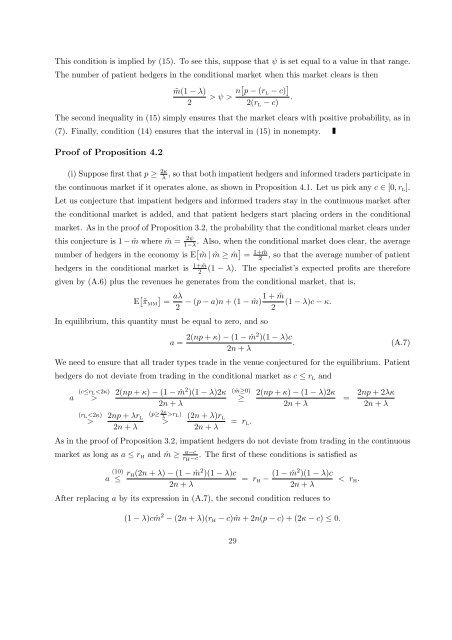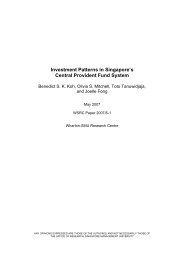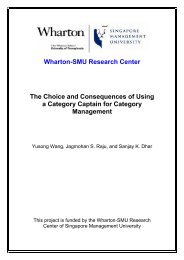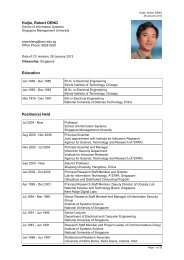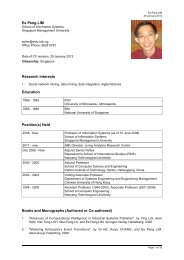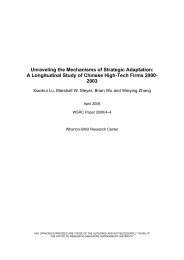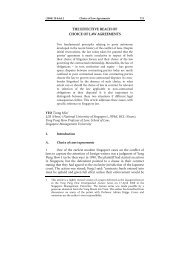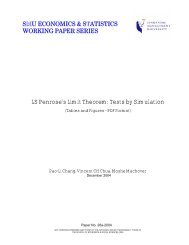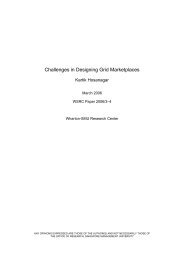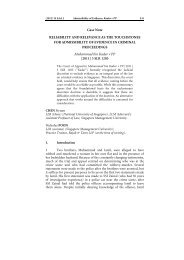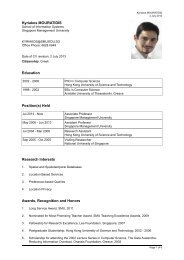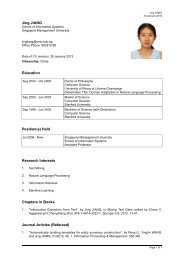The Benefits of Volume-Conditional Order-Crossing - Singapore ...
The Benefits of Volume-Conditional Order-Crossing - Singapore ...
The Benefits of Volume-Conditional Order-Crossing - Singapore ...
Create successful ePaper yourself
Turn your PDF publications into a flip-book with our unique Google optimized e-Paper software.
This condition is implied by (15). To see this, suppose that ψ is set equal to a value in that range.<br />
<strong>The</strong> number <strong>of</strong> patient hedgers in the conditional market when this market clears is then<br />
˜m(1 − λ)<br />
2<br />
> ψ > np − (rL − c) <br />
.<br />
2(rL − c)<br />
<strong>The</strong> second inequality in (15) simply ensures that the market clears with positive probability, as in<br />
(7). Finally, condition (14) ensures that the interval in (15) in nonempty.<br />
Pro<strong>of</strong> <strong>of</strong> Proposition 4.2<br />
(i) Suppose first that p ≥ 2κ<br />
λ , so that both impatient hedgers and informed traders participate in<br />
the continuous market if it operates alone, as shown in Proposition 4.1. Let us pick any c ∈ [0, rL]. Let us conjecture that impatient hedgers and informed traders stay in the continuous market after<br />
the conditional market is added, and that patient hedgers start placing orders in the conditional<br />
market. As in the pro<strong>of</strong> <strong>of</strong> Proposition 3.2, the probability that the conditional market clears under<br />
this conjecture is 1 − ˆm where ˆm = 2ψ<br />
1−λ<br />
number <strong>of</strong> hedgers in the economy is E ˜m | ˜m ≥ ˆm =<br />
hedgers in the conditional market is<br />
. Also, when the conditional market does clear, the average<br />
1+ ˆm<br />
2<br />
1+ ˆm<br />
2 , so that the average number <strong>of</strong> patient<br />
(1 − λ). <strong>The</strong> specialist’s expected pr<strong>of</strong>its are therefore<br />
given by (A.6) plus the revenues he generates from the conditional market, that is,<br />
E aλ<br />
˜π MM =<br />
2<br />
+ ˆm<br />
− (p − a)n + (1 − ˆm)1 (1 − λ)c − κ.<br />
2<br />
In equilibrium, this quantity must be equal to zero, and so<br />
a = 2(np + κ) − (1 − ˆm2 )(1 − λ)c<br />
. (A.7)<br />
2n + λ<br />
We need to ensure that all trader types trade in the venue conjectured for the equilibrium. Patient<br />
hedgers do not deviate from trading in the conditional market as c ≤ r L and<br />
a (c≤rL<br />
(rL<br />
2(np + κ) − (1 − ˆm 2 )(1 − λ)2κ<br />
2n + λ<br />
2np + λr L<br />
2n + λ<br />
(p≥ 2κ<br />
λ >rL)<br />
><br />
(2n + λ)r L<br />
2n + λ<br />
( ˆm≥0)<br />
≥<br />
= r L.<br />
2(np + κ) − (1 − λ)2κ<br />
2n + λ<br />
= 2np + 2λκ<br />
2n + λ<br />
As in the pro<strong>of</strong> <strong>of</strong> Proposition 3.2, impatient hedgers do not deviate from trading in the continuous<br />
market as long as a ≤ rH and ˆm ≥ a−c<br />
rH−c . <strong>The</strong> first <strong>of</strong> these conditions is satisfied as<br />
a (10)<br />
≤ r H(2n + λ) − (1 − ˆm 2 )(1 − λ)c<br />
2n + λ<br />
= r H − (1 − ˆm2 )(1 − λ)c<br />
2n + λ<br />
After replacing a by its expression in (A.7), the second condition reduces to<br />
(1 − λ)c ˆm 2 − (2n + λ)(r H − c) ˆm + 2n(p − c) + (2κ − c) ≤ 0.<br />
29<br />
< r H.


